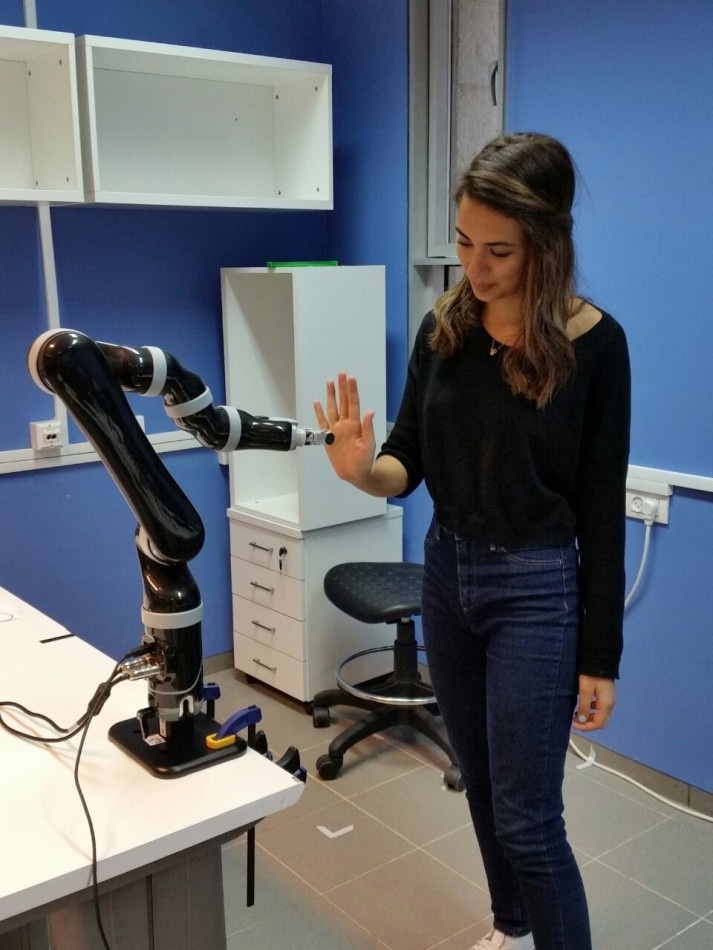Oct 24 2017
Researchers from Ben-Gurion University of the Negev (BGU) have started to find preferences in human-robot interactions and the requirement to personalize those encounters in order to fit both the human’s preferences and the selected task.
 Shir Kashi interacts with a robotic arm in BGU’s Cognition, Aging and Rehabilitation Lab, Department of Physical Therapy. Credit: American Associates, Ben-Gurion University of the Negev
Shir Kashi interacts with a robotic arm in BGU’s Cognition, Aging and Rehabilitation Lab, Department of Physical Therapy. Credit: American Associates, Ben-Gurion University of the Negev
As a first step to developing an interactive movement protocol to be employed in rehabilitation, researchers tested user preferences while interacting with a robot on a joint movement task, according to a new study published in the journal of Restorative Neurology and Neuroscience.
Dr. Shelly Levy-Tzedek, head of the Cognition, Aging and Rehabilitation Lab in BGU’s Department of Physical Therapy and a member of the Zlotowski Center for Neuroscience at BGU, focuses her study on the use of robots for rehabilitation of patients. Since many patients fail to practice their physical therapy routines sufficiently or not at all at home, she is designing robot companions in order to encourage them to practice and track their progress.
In the future, human beings may increasingly rely on robotic assistance for daily tasks, and our research shows that the type of motions that the robot makes when interacting with humans makes a difference in how satisfied the person is with the interaction, people feel that if robots don’t move like they do, it is unsettling and they will use them less frequently.
Dr. Shelly Levy-Tzedek, head of the Cognition, Aging and Rehabilitation Lab
In the study, a leader-follower mirror game was played with a robotic arm by 22 college-age participants, and in the game, a person and robot took turns following the joint movements of each other. When the robotic arm was leading, it made movements that were either smooth, like tracing a circle, or sharp, like dribbling a ball.
The study produced three major conclusions. First, the robotic movement primes the human movement, i.e., the person tends to imitate the robot’s movements. “This is a very important aspect to consider, for example, when designing a robotic nurse who assists a surgeon in the operating room,” Dr. Levy-Tzedek said. “You wouldn’t want a robotic nurse to make sharp “robotic” movements that will affect the way the surgeon moves his or her hands during an operation.”
Second, there was no clear preference for following or leading the robot. Half the group chose to lead the human-robot movement while half chose to follow.
This finding highlights the importance of developing personalized human-robot interactions. Just as the field of medicine is moving toward customized medicine for each patient, the field of robotics needs to customize the pattern of interaction differently for each user.
Dr. Shelly Levy-Tzedek, head of the Cognition, Aging and Rehabilitation Lab
Finally, the study participants chose smooth, familiar movements, which look like human movements, instead of unfamiliar or sharp (“robotic”) movements when the robot was leading interaction.
“Thus, determining the elements in the interaction that make users more motivated to continue is important in designing future robots that will interact with humans on a daily basis,” says Levy-Tzedek.
In March, the initial study by Shir Kashi, an undergraduate student, won a “best poster award” at the Human-Robot Interaction (HRI) Conference in Vienna. This study was an extension of her research. Kashi finished her undergraduate degree in cognitive sciences at BGU, and is currently starting her graduate studies in the lab.
The study was funded by the Israeli Science Foundation, Promobilia Foundation, Bronfman Foundation, and the Leir Foundation (grants # 535/16 and 2166/16). Additional funding was provided by the AABGU Marcus Endowment Fund as well as Helmsley Charitable Trust through BGU’s Agricultural, Biological and Cognitive Robotics Initiative.